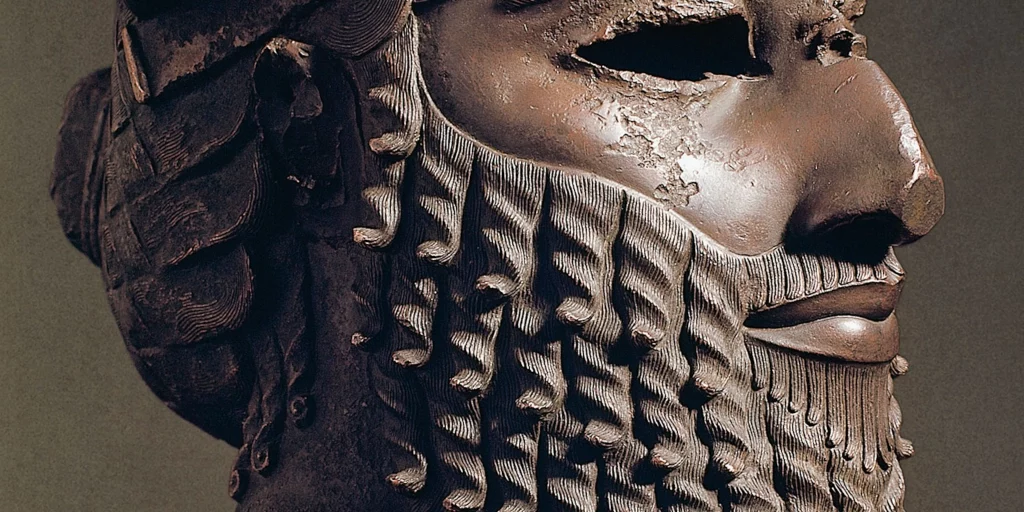Last updated on March 31st, 2024 at 08:24 pm
The universal relationship between religion and the use of mind-altering drugs is, of course, well documented in oral history. There is also plenty of physical evidence.
According to J. M. Allegro, author of The Scared Mushroom and the Cross, the Judeo-Christian belief system was heavily influenced by altered states of consciousness. This was produced through the use of hallucinogens such as the Amanita muscaria mushroom.
Similarly, in his book Soma: Divine Mushroom of Immortality, scholar R. G. Wasson contends that the ancient Indo-Aryans (Indo-Iranian-speaking pastoralists who migrated from Central Asia into South Asia) ingested soma.
He believes that this is the Amanita muscaria mushroom and that they ingested it during the writing of their most significant religious text, the Rig Vedat.
Additionally, an article written by researcher Jennifer Majchrzak titled “Peyote and Native American Culture,” explains the ritualistic use of peyote. It was used by members of the Native American Church. This is now the most widespread indigenous religion among Native Americans in the US.
Thus, with so many examples of hallucinogens being used to reach higher levels of consciousness, is it really so far-fetched that Joseph Smith used psychedelics in his quest for divinity? And that he founded his church on drug-induced visions?
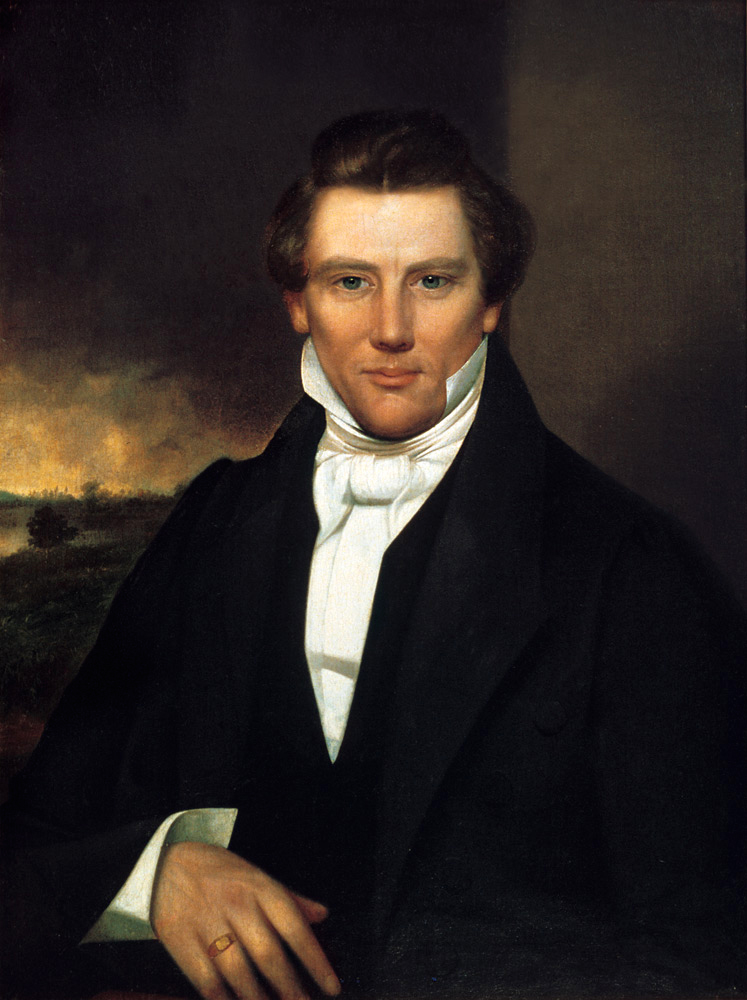
Early Life
Joseph Smith, Jr., was born on December 23, 1805, to a poor and what was considered “religiously unconventional” Vermont family.
His father, Joseph Sr., is said to have believed in magic. He was a follower of Universalist theology. They believed in a personal god and savior. They also believed in the Universalist doctrine that the atonement of Christ is sufficient to redeem all men.
His mother, Lucy, practiced Christian “Primitivistism.” This is the belief that a purer form of Christianity should be restored using the early Church as a model.
One of ten children (possibly 11), Smith contracted a crippling bone infection at the age of eight. This forced him to rely on crutches into his teens.
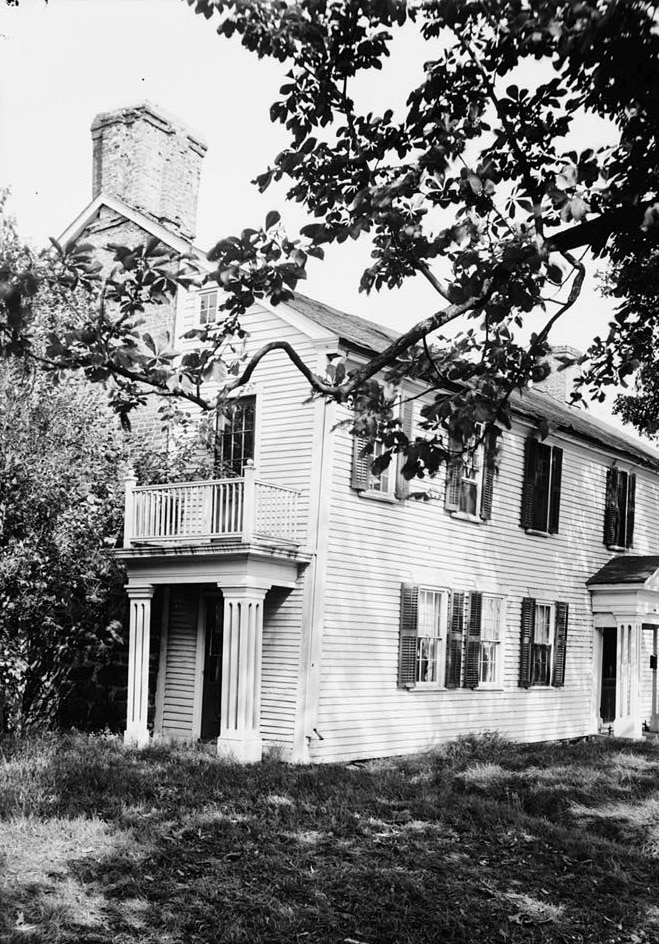
After struggling for several years to make ends meet as a farmer and merchant, in 1816, Smith’s father moved his family to western New York. They moved near Palmyra, where he accepted whatever work he could find.
They were also farming land rented on credit. The family ultimately lost their plot of land but continued to live there and farm it as tenants until 1831.
Despite his physical limitations, Smith worked the fields with his father and brothers. He also participated in many money-making endeavors with the senior Joseph. Between his field-hand duties and physical limitations, it appears that Smith received no formal education.
Visions
At the age of 14, Smith experienced what followers of the Mormon faith accept as his first prophetic vision.
While in a spiritual retreat in a grove near his family farm, Smith is said to have knelt in prayer. He was addressing the matter of which religious group to follow. At this time, he was visited by God and Jesus, who hovered above him in mid-air.
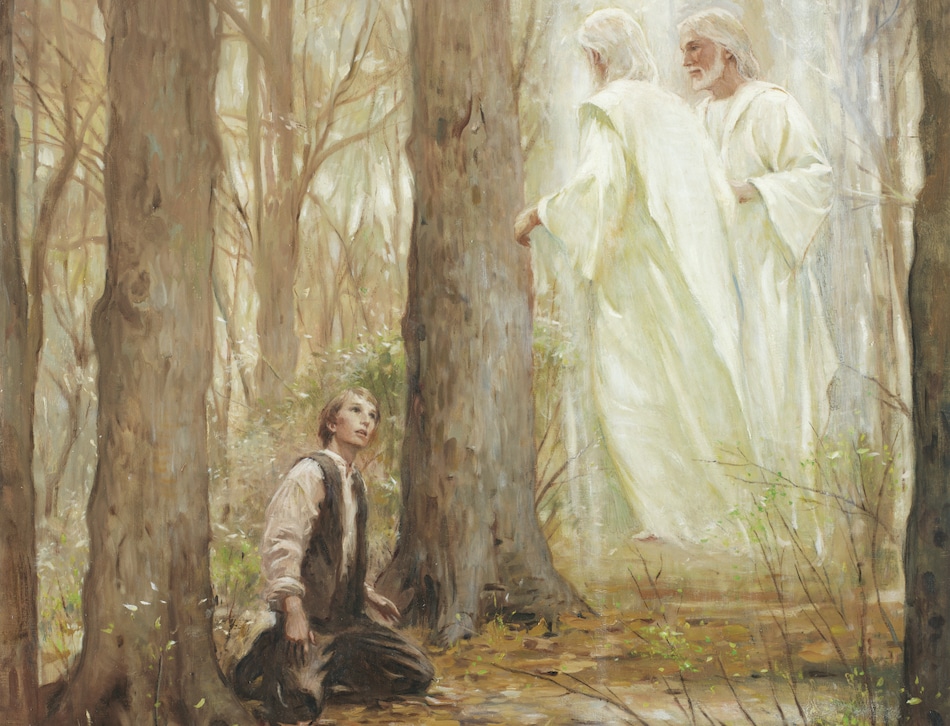
In his diary, he later wrote, “The Lord heard my cry in the wilderness, and while in the attitude of calling upon the Lord a pillar of light above the brightness of the sun at noonday came down from above and rested upon me and I was filled with the spirit of God and the Lord opened the heavens upon me and I saw the Lord.”
Though Smith did not immediately divulge the details of this first religious epiphany to his family, he told them that he now knew with certainty that the true Christian Church was not yet present on Earth.
Seer or Scammer?
Between 1922 and 1927, the Smiths, like many families living in Vermont at that time, sought to supplement their income. They participated in an activity known as “treasure-digging.”
Joseph Sr. was known to townspeople as a man whose beliefs leaned towards the occult. He also practiced scrying. This involved using a mirror or bowl of water to divine the future.
Encouraged his son (who is said to have already begun displaying a gift for prognostication) to utilize a “seer stone.” This is a small, amulet-like stone thought capable of transmitting revelations from God which could, among other things, help locate lost objects of value.
As explained in Mormon church archives, Smith would place his “seer stone” in the crown of his hat. He would then bend forward with his arms resting on his knees, his face buried in his hat.
Gazing into the stone while in this position, he would visualize and then dictate (as if in a trance) what he saw to someone sitting nearby. That person would then record it.
According to Smith legend, he became very proficient at divining by this method. On at least one occasion, he was hired to lead a company to a cache of gold believed buried nearby by earlier residents. (As it turned out, Smith could not divine the location.)
Urim and Thummim
On the night of September 21, 1823, at the age of 17, Smith is said to have experienced his second prophetic vision.
He was calling upon God for forgiveness for his “gratification of many appetites.” This was, presumably, sex and alcohol.
He was visited by an angel named Nephi (referred to as “Moroni” in later texts). It revealed to him the location of a book written on thin golden plates inscribed with an historical record of a group of earlier inhabitants of North America.
With these plates were “two stones in silver bows and these stones [which when] fastened to a breastplate” constituted what Nephi called the “Urim and Thummim.” These were a pair of seer stones buried in a hill known as Cumorah, a few miles from Smith’s family home.
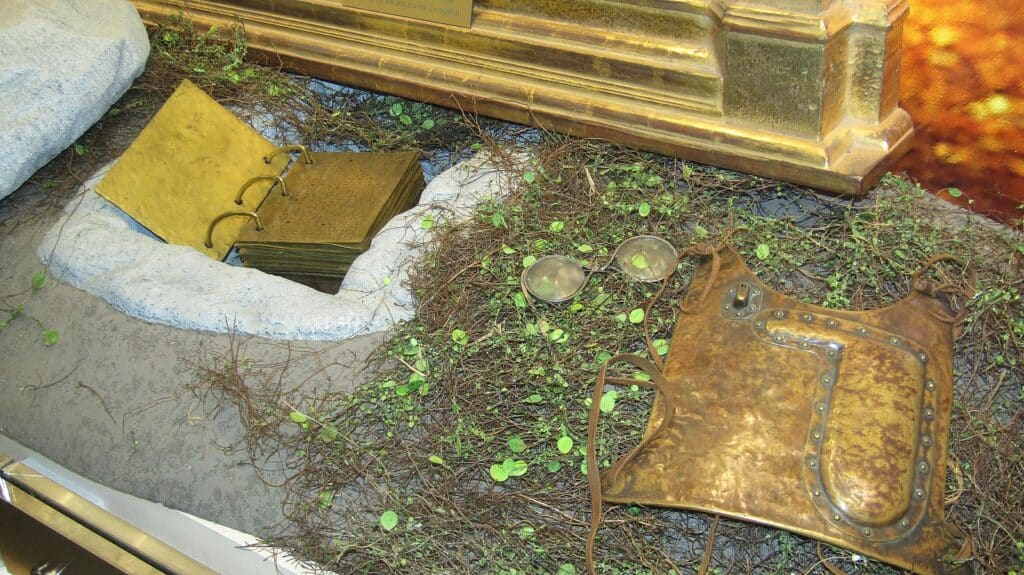
According to Smith, these plates not only explained the origins and history of these earlier inhabitants, they imparted the “fullness of the everlasting Gospel.” They had been “delivered by the Savior to these ancient inhabitants.”
Smith would later tell his followers that upon digging in the designated spot, he unearthed a stone box. This box held golden plates exactly as described, as well as the “Urim and Thummim,” the keys to translating the plates.
But before he could remove the plates from the box, Nephi appeared again. He informed Smith that before he could take formal possession, he must undergo a four-year purification process.
During this, he would need to return to the same spot at Cumorah on the same day each year. Only on the fourth visit would he be permitted to take possession and begin translating the plates.
The Ten Lost Tribes of Israel
According to Mormon church lore, Smith took possession of the plates on September 22, 1827, and soon after, he began the translation process.
He was said to have been written in “reformed” Egyptian characters only decipherable using the “Urim and Thummim.” But Smith was able to dictate a complete translation of the text to Oliver Cowdery (Smith’s first “apostle”) by 1930.
(Cowdery is said to have been one of three men who witnessed first-hand the golden plates that resulted in the Book of Mormon.)
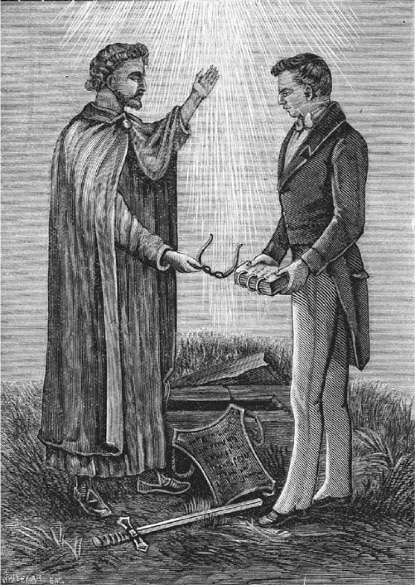
The resulting text is said to have been a condensed history of a group of religious pilgrims descended from one of the original 12 tribes of Israel. They had fled Jerusalem shortly before the destruction of the first Temple in 586 BCE. This was recorded by a man named “Mormon.”
It explained that the wandering Israelites built a boat, crossed the Atlantic, and eventually came ashore somewhere in the Americas. They were led by a Jewish patriarch.
Some five centuries later, Christ appeared to them after his resurrection. He converted them to Christianity, and for a century to follow, the tribe lived in peace and prosperity.
As time passed, however, discord grew. Some of the converts became pagan non-believers. Finally, about 400 years later, the Jewish/Christian converts were defeated in a series of great wars waged by the non-believers.
Prior to these wars, however, Nephi hid Mormon’s golden plates until such a time that God would call them into use again. With these plates now (said to be) in Smith’s possession, he claimed that God had chosen him to found the true Christian Church in America.
(Interestingly, some modern Ojibwe groups of America’s Northeast subscribe to a myth describing them as one of the Twelve Lost Tribes of Israel.)
The Mormon Church of Christ
Speaking now for God, Smith announced the restoration of an ancient priesthood into which those who sincerely repent their sins could be baptized. This was the restored Church of Jesus Christ; the only true Christian Church on Earth.
He quickly became known as the Mormon prophet (or simply, “the Prophet”). Smith began referring to his followers as “Mormons” and to his movement as “Mormonism.”
They identified themselves with Christians of the “Apostolic Age” (the time of the 12 Apostles) who were referred to as “saints.” They held the expectation that the end of days was near.
The Mormon Church of Christ was officially founded in 1830. Its members subsequently deemed themselves, “Latter-day Saints.”
Early acolytes were quick to accept theirs as the only legitimate Christian institution on Earth. They believed they were led by one in direct communication with God.
Several of his first adherents sought direct experience with God. They believed that Smith had the power to bestow it.
According to ample documentation and testimonials, between 1830 and 1836, many early Mormons did indeed experience “heavenly visions” and “spiritual raptures” under Smith’s direction. The question, of course, is by what means?
Bread, Wine, and Oil
Following the first conference of the newly-founded Mormon Church at Fayette, New York, in June of 1830, Smith recorded the following event:
“Having opened by singing and prayer, we partook together of the emblems of the body and blood of our Lord Jesus Christ. . . . The Holy Ghost was poured out upon us in a miraculous manner, many of our number prophesied, others had the heavens opened to their view, and whilest some were so overcome that we had to lay them on beds . . . all of a sudden, a vision of the futurity burst upon [one]. He saw there represented the great work which through my instrumentality was yet to be accomplished. He saw Heaven opened and beheld the Lord Jesus Christ, seated [at] the right hand of the majesty on high, and had it made plain to his understanding that the time would come when he should be admitted into his presence to enjoy his society for ever and ever.”
Joseph Smith, 1830
Most modern scholars agree that this entry describes nothing less than a congregation experiencing altered states of consciousness. Possibly after ingesting entheogens; psychoactive, hallucinogenic substances.
This includes psilocybin or ayahuasca. These are derived from plants or fungi. They have historically been used in religious, spiritual, or ritualistic scenarios.
The consensus is that Smith’s reference to “emblems of the body and blood of our Lord Jesus Christ” is a thinly veiled reference to the successful delivery of hallucinogen-laced bread and wine. This is supported by subsequent Mormon Church log entries.
According to an archived Latter-day Saints account regarding “heavenly manifestations” occurring during a March 18, 1833 sacrament meeting held in Kirtland, Ohio, “Bro Joseph . . . promise[d] that the pure in heart that were present should see a heavenly vision . . . after which the bread and wine was distributed by Bro Joseph after which many of the brethren saw a heavenly vision of the savior and concourses of angels”
Similarly, Latter-day Saint Ebenezer Robinson reported that on the afternoon of March 27, 1833, after the administration of the bread and wine, “Frederick G. Williams bore record that a holy angel of God came and sat between him and Joseph Smith . . . while the house was being dedicated.”
Likewise, visions are said to have manifested following the application of anointing oil at a Church gathering on January 21, 1836.
Smith wrote, “After first being anointed [my]self and then in turn anointing several of the Brethren, the heavens were opened upon us and I beheld the celestial kingdom of God, and the glory thereof, whether in the body or out I cannot tell.” Joseph further noted that all through the night he saw visions and that many of his brethren “saw glorious visions also.”
Additionally, several newspaper accounts of Church activities including this from the Independent Messenger, Worcester, Massachusetts, reported that on May 27, 1831, “Some lie in trances a day or two and visit the unknown regions in the meantime; some are taken with a fit of terrible shaking which they say is the power of the Holy Ghost.”
Did Joseph Smith Have Access to Hallucinogens?
Central to the premise that Smith not only used psychedelic drugs but covertly administered them to his congregation hinges, of course, on the feasibility of access.
Simply stated: Is it likely that Smith had access to hallucinogens? And according to Museum Director Richard Evans Schultes of the Botanical Museum of Harvard University, the answer is an unequivocal, yes.
Considering the geographic area in which Smith was known to have lived and traveled, he would have had relatively easy access to at least two known natural hallucinogens: the Amanita muscaria mushroom, and several varieties of Datura.
Additionally, arranging to trade or barter with the local Native groups (the Abnaki, for example, an indigenous group of Vermont known to cultivate and use the Acorus calamus plant for its psychoactive effects) would have been simple.
Closing Thought
It’s impossible to state emphatically that Joseph Smith founded the Mormon Church of Christ on drug-induced visions. However, it’s interesting to note that after Smith’s death in 1844, the so-called “visionary” period of the Church is said to have come to an abrupt end.
Even 20 years later, Church members were envious of the spiritual enlightenment of that period. They continued to ask Church leaders why they no longer saw angels and had visions; why they did not see great manifestations of God’s power as in the beginning.
References
Allegro, John M., The Sacred Mushroom and the Cross, https://archive.org/details/sacredmushroomcr0000john
Wasson, R. G., Soma: Divine Mushroom of Immortality, https://archive.org/details/in.ernet.dli.2015.449342
opensiuc.edu., “Peyote and Native American Culture,” https://opensiuc.lib.siu.edu/cgi/viewcontent.cgi?article=1509&context=ebl
history.churchofjesuschrist.org., “Joseph Smith Jr., First President of the Church,” https://history.churchofjesuschrist.org/landing/prophets-of-the-restoration/joseph-smith?lang=eng
Bushman, R. L., Joseph Smith:Rough Stone Rolling, https://archive.org/details/josephsmithrough00bush
chuchofjesuschrist.org., Book of Mormon, https://www.churchofjesuschrist.org/study/scriptures/bofm?lang=eng
Owens, L. S., “Joseph Smith and Kabbalah: The Occult Connection,” Dialogue: A Journal of Mormon Thought, https://archive.org/details/45225963
Pratt, O., The Pearl of Great Price (1851), https://archive.org/details/PearlOfGreatPrice1851
www.churchofjesuschrist.org., “Church History,” http://lds.org/churchhistory/0,15478,3900-1,00.html.
Schultes, R. E., The Plants of the Gods: Their Sacred, Healing, and Hallucinogenic Powers, https://archive.org/details/plantsofgodsorig00schu
naeb.brit.org., “Abnaki,” http://naeb.brit.org/uses/search/filtered/?string=&tribe=1&use_category=4

